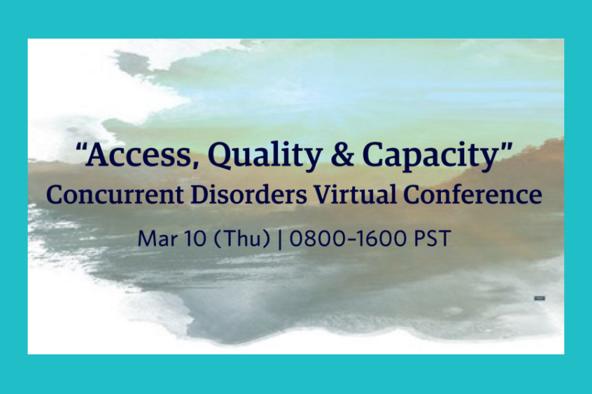BC Concurrent Disorders Conference returns to address access, quality and capacity

Concurrent disorders is the term used to describe a condition where a person lives with both a severe mental illness and drug addiction. These clients are vulnerable and very ill, and many experience high levels of stigma, homelessness, and trauma.
The theme of this year’s virtual event is “Access, Quality & Capacity.” Participants will discuss and learn from people with lived experience, and national and international experts who work in concurrent disorders, about how to collectively improve BC's mental health care system, in supporting our most vulnerable.
Dr. Vijay Seethapathy is chief medical officer for BCMHSUS and lead organizer for the conference.
The theme of the conference is “Access, Quality and Capacity.” What does that mean?

In an emergency room in a hospital, or in cancer care for example, we have provincial benchmarks that dictate patients must be treated in a certain amount of time. We need the same thing for mental health.
We would need to compare our service with national and international best practice indicators and continuously improve the quality of care we provide. As a part of the conference we hope to have an expert panel discussion, visioning the future of the mental health and substance use care system in BC.
Are there ideas or practices from other regions that we should be applying in BC?
Early intervention for people who suffer from concurrent disorders is key. If we look at other jurisdictions such as the United Kingdom & New Zealand, they have made great strides to address this. One of our key speakers at the conference is Andrew Slater, the CEO of New Zealand National Telehealth Services. His keynote will highlight the national telehealth service model and how it acts as the first line of defence in mental health care in New Zealand. This model also outlines the importance of effective integration of the wider health sector. It functions as a one-stop shop for people in need to provide access and early intervention without channelling them through multiple doors.
You have people with lived experience of substance use and mental disorders as speakers and participants in this year’s conference. Why is it important to include their perspectives?
One of the things about transforming and improving the system is to break the barriers and stigma surrounding mental health and substance use disorders. We need to understand how stigma impacts people, and we can’t do that without hearing their voices. Clearly, stigma will impact clients seeking help. And if you don’t seek help at the right time, interventions might not be fruitful or effective. A key element of reducing stigma is to look at the person as a whole. By that I mean we need to understand the biological, social and psychological dimensions of mental health and addictions. What are the root causes, and what traumas have people suffered in the past? We need to hear from people who have been through our care system so they can tell us what is working and what needs improvement – who better to share these insights than the individuals with living experience?
When you look at the mental health and substance use system in BC, what makes you optimistic?
While there are undoubtedly challenges in our system, there are also many reasons for optimism. There is an increasing awareness of the mental health needs of the population as a whole. COVID has hurt us a lot, especially the impact on mental health, but at the same time there is more awareness than ever. I sense an openness to have more dialogue to drive real change. We have a tremendous opportunity to shape the future of the mental health and substance use care system. It is time to break free from firefighting mode, be more proactive, and explore ways to revolutionise how care is delivered. I’m optimistic because I see renewed interest and increased investments in mental health and substance use care. I want to come together and envision the next 5-10 years and how the future of mental health and substance use care should look in our province, and what can be done to improve the system as a whole.